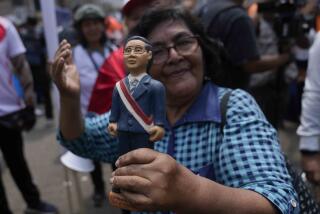Peru Prods Coca Farms to Go Legal
- Share via
SAN FRANCISCO, Peru — This forlorn hamlet deep in the Apurimac River Valley, one of Peru’s coca heartlands, was once a jungle boomtown of sorts.
The coca industry churned out fast cash that left few traces on the village’s rocky and bedraggled streets. The peasants frittered away the money on liquor, clothes--”the good life,” villager Regulo Rojas said.
During the last two years, as the Peruvian air force shut down aerial smuggling routes, coca prices plummeted.
Today, San Francisco’s houses still have no glass in their windows and its farmers have little hope of a better life. The valley has been hit hard by the slump in coca prices. This is an ideal time and place for a quixotic and neglected strategy, experts say: the development of alternative crops.
So a crowd sweated in the village square last month waiting for President Alberto Fujimori and Barry R. McCaffrey, the U.S. drug czar, who was on a two-day visit to Peru. The two leaders were scheduled to announce a U.S.-Peruvian plan to coax coca farmers into planting legitimate crops.
But Fujimori and McCaffrey never arrived. Fog forced their helicopter to turn back, a disappointment that symbolized the historic neglect of this lush and treacherous land--and the obstacles confronting alternative development.
“We are having a very bad time,” Rojas said. “We know that it would be better to change to another crop, but this is very difficult.”
*
Peruvian peasants have clung to coca in defiance of the law ever since Francisco de Toledo, the viceroy of Lima, issued edicts against the substance in the late 1500s. About 200,000 Peruvians live off coca cultivation, supplying two-thirds of the drug consumed in the United States.
The price of coca leaf has dropped from $26.80 to $16.90 per bushel--about 27 pounds--since January 1995. But the plant is still more profitable and easier to transport than legal crops. And although police have caught several drug lords--arresting Peru’s most-wanted kingpin in Ecuador this week--the government must also uproot a rural culture and economy based on coca.
Peasants “have to find some way to survive with dignity and with an opportunity to contribute,” McCaffrey said while in Peru.
The carrot-and-stick approach has its ironies. Here in San Francisco, the center of a rugged region of about 25,000 inhabitants, the U.S. Agency for International Development has funded emergency food relief for peasants hurt by the U.S.-sponsored drug-interdiction campaign.
Despite skepticism among hard-liners in the U.S., some experts believe that alternative development in cooperation with farmers deserves a chance. Peru differs markedly from Colombia, where a forced crop eradication program has provoked a violent uprising among growers aligned with leftist guerrillas.
Peruvian security forces have largely broken the link between peasants and the Maoist rebels of Sendero Luminoso, or Shining Path. The rebels bankrolled their operations partly through the drug trade, and they assassinated alternative development counselors along with mayors and soldiers.
Authorities are now trying to distance the peasants from traffickers with offerings such as the $44-million binational crop-replacement project, of which Peru is paying $14 million. Officials have negotiated voluntary agreements with communities to phase out coca in exchange for physical and financial infrastructure: schools, hydroelectric plants and roads connecting villages to markets. AID and other agencies will help plant substitute crops such as coffee, cotton and tropical fruit.
More to Read
Sign up for Essential California
The most important California stories and recommendations in your inbox every morning.
You may occasionally receive promotional content from the Los Angeles Times.













